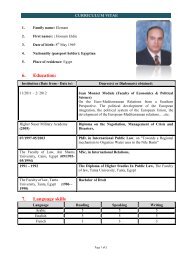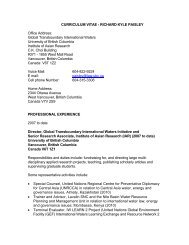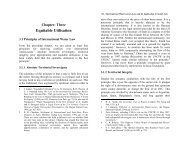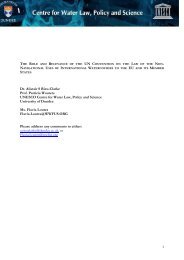Upreti, Trilochan, International Watercourses Law and Its Application ...
Upreti, Trilochan, International Watercourses Law and Its Application ...
Upreti, Trilochan, International Watercourses Law and Its Application ...
Create successful ePaper yourself
Turn your PDF publications into a flip-book with our unique Google optimized e-Paper software.
214 / <strong>International</strong> <strong>Watercourses</strong> <strong>Law</strong> <strong>and</strong> <strong>Its</strong> <strong>Application</strong> in South Asia Prospects <strong>and</strong> Problems of Nepalese Water Resources / 215impact on the environment <strong>and</strong> to improve the balance ofpayments situation, development of hydropower is essential. 107Keeping all the above facts in view, together with the risingdem<strong>and</strong> for electricity in northern India due to rapidindustrialisation there, with an approximate deficit of 30,000MW predicted for the year 2005, Nepal would benefit ifhydropower could be generated <strong>and</strong> exported to the powerhungryregions of that country. In addition, by developing largeexport-oriented multipurpose projects such as Pancheshwar,Karnali, <strong>and</strong> Saptakosi, about 22,000 MW of electricity can begenerated. Steps should be considered to enable the extractionof economic benefits from the export of power <strong>and</strong> theprovision of irrigation <strong>and</strong> navigation facilities to India <strong>and</strong>Bangladesh. 108The truth about India is that she has utilised almost every dropof available water for irrigation, beyond the Nepal-India border,by constructing huge reservoirs <strong>and</strong> systems of irrigationnetworks, concerning which she has never provided Nepal withthe requisite information. Such reservoirs have virtuallysubmerged Nepalese l<strong>and</strong> in several areas, 109 namely Banke,Kapilvastu, Rapti, Dang, Rup<strong>and</strong>ehi, Rautahat, Mahotari <strong>and</strong>Mahendranagar. Except for taking a few mitigatory steps insome areas, 110 she has neither compensated Nepal nor givenassurances that she will not repeat such harmful projects in the107 Supra note 98, p. 498.108 Ibid. p. 498-499.109 Supra note 39, p. 340.110 Supra note 22: In relation to the submergence of the entire territory of 16 VDC in BankeDistrict, as an effect of the Laxmanpur barrage, both governments have undertakenmitigation efforts, such as constructing embankments in the affected areas. However,such work so far seems ineffective in averting or mitigating the inundation caused by thebarrage. Also see staff, “the joint St<strong>and</strong>ing Committee on Inundation Problems Fail toresolve problems”, in the Kathm<strong>and</strong>u Post, 13 August, 2003, constituted by the PrimeMinisters of both countries to resolve the flood problem, held a meeting recently inwhich Nepal proposed either the dismantling of the bunds or payment of sufficientcompensation. This was refused by India <strong>and</strong> no resolution was agreed; rather, the Indianside even refused to acknowledge the issue of inundation of huge areas of Nepaleseterritory, even after a site tour <strong>and</strong> the presentation of data on flood waters. In Rato <strong>and</strong>Kh<strong>and</strong>o river embankments are being constructed in which India has provided money.years to come. On the contrary, it seems that she is constructingdozens of such reservoirs <strong>and</strong> barrages beyond the border point,the back-up water of which will naturally submerge a hugechunk of Nepalese territory. In essence, she never follows theprinciple of ‘equitable utilisation’ <strong>and</strong> the ‘no harm rule’,rather, she has always behaved against these norms, <strong>and</strong> alsoagainst the existing trend currently adopted even in interstatedisputes within India. 111 The Indian projects which wereconstructed without giving information <strong>and</strong> notice as requiredby international law <strong>and</strong> practice are in obvious breach ofArticles 5-9 of the UNCIW.Several diplomatic initiatives were made by Nepal, <strong>and</strong> noteswere also sent to India. Furthermore, negotiations were held towipe out such illegal acts, but no tangible result has so far beenachieved. Nevertheless, a different view of Indian’s positionseems to be reflected in a statement by the Indian State ofBihar’s Water Resources Minister who is quoted as saying thatfor whatever area was submerged due to the G<strong>and</strong>ak Barrage inAugust 2002, the Indian government would pay compensationto Nepalese farmers. 112Nepal has a maximum potential requirement to irrigate only 3.2million hectares, but has a far greater abundance of wateravailable; whereas the downstream countries have large areasof l<strong>and</strong> to irrigate, but only limited water available with whichto do so. 113 So far, India, being an economically advancedcountry, has developed <strong>and</strong> used almost all feasible projects,whilst Nepal still needs to use such waters, <strong>and</strong> is hinderedfrom developing any projects due to Indian objections <strong>and</strong> nonco-operation. Whether or not it is justifiable in internationallaw, Nepal, the poorer country as the upper riparian state, isprohibited from utilising her own resources, whereas the lower111 Supra note 52, pp. 313-316.112 Staff, “Nepal to receive compensation from India”, in The Katm<strong>and</strong>uPost 12 August, 2002.113 Supra note 1, p. 55.












